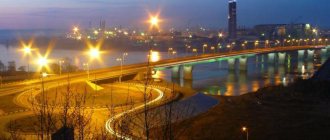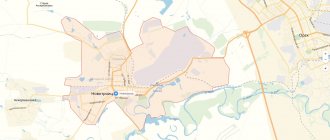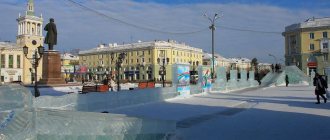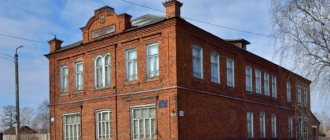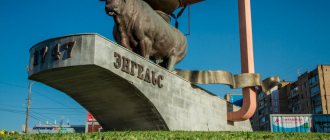Geographically, Novokuznetsk is divided into 6 districts:
- Kuibyshevsky;
- Central;
- Factory;
- Kuznetsky;
- Ordzhonikidzevsky;
- Novoilinsky.
The current administrative center is located in the Central district of the city, while the historical center is located in the oldest district of the city - Kuznetsky, where Sovetskaya Square and the Kuznetsk Fortress are located. The structure of the location of district streets, as well as the roads connecting them in Novokuznetsk, is quite complex, so for orientation it is better to use a map of Novokuznetsk with streets in good quality.
Airport
The main airport of Novokuznetsk, Spichenkovo, is located approximately 20 kilometers from the city center in a westerly direction between the regional city of Prokopyevsk and the village of Luchshevoy. The air harbor has international status. The airport is capable of receiving aircraft of various classes, including Airbus A320 and Boeing 737-800, and any types of helicopters. The terminal's capacity is about 200 people per hour.
At the moment, Novokuznetsk Spichenkovo Airport serves only Russian airlines. The largest number of flights are operated within Russia. Flights are carried out year-round and every day to Moscow, 2-3 times a week to Novosibirsk and Krasnoyarsk, according to a seasonal schedule - to Sochi, Anapa, Simferopol and other destinations. International flights also operate on a seasonal schedule. The main destinations are Antalya, Cam Ranh and Sanya (Hainan Island).
Spichenkovo Airport can be reached from Novokuznetsk by bus from Oktyabrsky Prospekt. Bus service is also established with Prokopyevsk (the final station is the village of Tyrgan).
Housing stock and architecture. Houses on the map of Novokuznetsk
The city's housing stock is dispersed throughout all districts. In the Kuznetsk region, buildings from Stalin's times predominate with the corresponding architectural design of the facades. “Stalin's houses” are also present in the city center, being architectural monuments that attract tourists. You can find them on almost all the streets of the city center while walking or using a map of Novokuznetsk with houses.
In the Zavodsky and Kuibyshevsky districts, residential buildings are built primarily of brick and are classic Soviet 5-story buildings. The Novoilinsky district is being built up with panel houses and is considered a modern area with a more convenient infrastructure layout. The central district does not have a single architectural style, and its streets often form a complex interweaving, so finding the required address is sometimes only possible using a map of Novokuznetsk with house numbers.
Elite residential real estate is actively being built in Novokuznetsk, located in the Central region (multi-storey complexes) or in suburban areas (cottage communities). The most popular among city residents are the Fregat residential complex, located at the junction of Ordzhonikidze Street and Kuznetskstroevsky Prospekt, new buildings on Ermakov Avenue, as well as luxury high-rise buildings at ul. Tolyatti no. 62 with a view of the city administration. A detailed map of Novokuznetsk will help you find all the luxury real estate objects in the city.
Train Station
The railway station (Novokuznetsk station) is located in the Kuibyshevsky district on Transportnaya Street, 2. Short- and long-distance trains depart from the station electrically (including to foreign countries). Popular year-round routes within Russia are St. Petersburg, Moscow, Kislovodsk, Vladivostok, Tomsk, Tyumen. According to the seasonal schedule, trains depart to Anapa, Sochi and Barnaul. Direct non-stop communication operates with the Kyrgyz capital Bishkek (stops are possible in intermediate settlements in Kazakhstan).
Short-distance electric trains from the Novokuznetsk railway station go to Belovo, Mundybash, Mezhdurechensk, Karlyk, Erunakovo and the Uskorennaya station in Novosibirsk with stops in intermediate settlements.
Main industries of Novokuznetsk
First of all, this area is famous for its coal seam deposits, which have been mined on a large scale from the 18th century to the present. The coal industry occupies a leading position in this region. Metallurgy, both ferrous and non-ferrous, as well as mechanical engineering of various equipment for the mining industry are also developed in Novokuznetsk. The electricity generated by the district's thermal power plants is sufficient not only for the needs of the population, but also for the industrial enterprises of Novokuznetsk. Pharmacology is represented by a large pharmaceutical enterprise. There are also enterprises producing construction materials. It should be noted that marbles are mined in this region, which occupy a leading position among similar products in Russia in terms of color shades and patterns. They are successfully used in construction work. Novokuznetsk is a very rich and industrialized region. Products produced here are supplied to all regions of Russia and are also exported abroad.
Bus station
The Novokuznetsk bus station is located next to the railway station on Transportnaya Street, 4. The Novokuznetsk bus station is one of the largest transport hubs in the West Siberian region as a whole. Buses depart from here to more than 50 destinations, including international:
- Intersubject routes: Barnaul, Tomsk, Novosibirsk (including a special bus to Tolmachevo airport), Krasnoyarsk, Belokurikha and the Kazakh city of Temirtau.
- Intercity routes: Kemerovo, Benzherep, Kiselevsk, Tashtagol, Osinniki, Mezhdurechensk, Leninsk-Kuznetsky, Guryevsk, Sary-Chumysh, etc.
- Suburban routes: Gavrilovka, Apanas, Novokazankovo, Malinovka, Fedorovka, Prokopyevsk and a number of other settlements.
Metallurgical industry of Novokuznetsk
The metallurgical industry of the Novokuznetsk region is represented by ferrous and non-ferrous metallurgy. This is facilitated by a large number of different minerals, deposits of which have been discovered near Novokuznetsk. Indeed, at this time, about 90 deposits and two dozen mine deposits of various valuable metals have been identified. Among them are silver and gold, mercury, chromium, tungsten, copper, manganese and many others. A base for the development of non-metallic minerals, which are used in the metallurgical industry, has also been established in the Kemerovo region. These are minerals such as molding sands, dolomites, quartzites, refractory clays, and fluxing limestones. Ferrous metallurgy is represented by the plant, which is currently called OJSC EVRAZ West Siberian Metallurgical Plant. And also JSC “Kuznetsk Ferroalloys” Non-ferrous metallurgy is represented by the Novokuznetsk Aluminum Plant.
Ferrous metallurgy of Novokuznetsk
The history of the Kuznetsk Metallurgical Plant, on the basis of which OJSC “EVRAZ West Siberian Metallurgical Plant” is now created, begins back in the 20s of the last century. Then young Komsomol guys built a metallurgical plant in Kuzbass in record time, the first enterprise of this profile in Western Siberia. First, the construction and then the plant were led by a talented metallurgist, future member of the USSR Academy of Sciences, Ivan Pavlovich Bardin. By independently correcting the plant construction plan provided by a German company, he was able to significantly increase the usable production area, and at the same time increase the output of cast iron by more than three times the original plan. Following cast iron, the metallurgical plant began producing steel and rolled rails.
During the Great Patriotic War, almost half of all aircraft, tanks and shells of the USSR were manufactured at the Kuznetsk Metallurgical Plant. However, currently most of the workshops are closed and dismantled. Of the existing production, only the rail rolling shop remains. It should be noted that the first hundred-meter rails were produced at this plant, and 60% of all rails laid on the railways of the CIS countries were also produced at EVRAZ ZSMK. Among the ferrous metallurgy enterprises of Novokuznetsk, JSC Kuznetsk Ferroalloys should also be noted. It was founded in 1942, when the Zaporozhye Ferroalloy Plant was evacuated to Kuznetsk. This plant produces ferrosilicon, which is a valuable additive in the production of cast iron, making it more durable.
Non-ferrous metallurgy of Novokuznetsk
The non-ferrous metallurgy of Kuzbass is represented by the Novokuznetsk Aluminum Plant. It was launched in 1943, when the country was in great need of products of this kind. Half of the attack aircraft, bombers, and fighters were made from Kuznetsk aluminum.
Since then, the plant has been steadily developing, modernizing its production and expanding its range. Currently, its productivity is more than 200 thousand tons of aluminum per year, more than half of which are multicomponent alloys. The plant's facilities are currently certified in accordance with international standards, which allows products to be exported to many countries around the world.
Automobile highways
There are currently no federal highways connected to Novokuznetsk, but the only ring road in the entire Kemerovo region runs around the city, from which there is a branch to the regional road P366 (connects the city with the southern regions of the Altai Territory).
The Novokuznetsk ring road has 8 exits - at the 0th, 4th, 14th, 25th, 26th, 29th, 31st and 50th kilometer. Thus, you can enter and exit the city in any direction.
The city of Novokuznetsk is one of the most significant industrial centers of the country and has a pronounced specialization - metallurgical production, coal mining, industrial and civil construction. Novokuznetsk has two full metallurgical cycle plants, an aluminum and a ferroalloy plant, producing more than 60% of the industrial products produced in the city. Also on the territory of Novokuznetsk there are two thermal power plants, construction industry enterprises, and a number of municipal boiler houses. This concentration of industrial enterprises and the state of their technological and treatment equipment creates a tense environmental situation.
Regarding the air basin, the current situation is characterized as follows:
- 1. As of 01/01/2010 On the territory of the city, 4,259 stationary sources of emissions of pollutants into the atmosphere are registered, including 2,762 organized ones.
- 2. In 2009, 325.9 thousand tons of pollutants of 89 types were released into the atmosphere of the city of Novokuznetsk. The main share in the total mass of urban emissions into the atmosphere are: carbon monoxide - 60.4%; methane - 10.1%; solids - 10.6%; sulfur dioxide - 12.3%, nitrogen dioxide - 4.8%.
Mobile sources of pollution include all types of road transport. In 2009, according to the traffic police of Novokuznetsk, there were 10,509 units of freight vehicles registered, 131,732 units of passenger vehicles, and 3,286 units of buses. Gross emissions of pollutants into the atmosphere from mobile sources in 2009 amounted to 76.54 thousand tons.
Novokuznetsk is one of the few cities in the Kemerovo region that has on its territory a branch of the state service for hydrometeorology and environmental monitoring. The Novokuznetsk Hydrometeorological Service monitors air pollution at eight stationary posts in all districts of the city. According to observational data, the city's atmosphere is most polluted with benzo(a)pyrene, formaldehyde, suspended solids, nitrogen dioxide and hydrogen fluoride.
The hydrographic network of the city of Novokuznetsk is represented by the main water artery of the region - the Tom River and its tributaries, the main of which are Kondoma, Aba, Gorbunikha, Konobenikha, Petrik, Osinovka, Druzhinina, Kommunarka, Chesnokovka, Baidaevka and other small rivers and streams. In addition, there are artificial water bodies on the territory of the city: canals and reservoirs of enterprises; exhausted quarries filled with water.
In 2009, 315.69 million m3 of fresh water was taken, including 265.2 million m3 of fresh surface water, 44.6 million m3 of underground water, and 5.12 million m3 of mine water.
In the city of Novokuznetsk, the sources of centralized household and drinking water supply are the Tom River and underground wells. Drinking water supply for residents of the city of Novokuznetsk is provided by 4 independent water pipelines: Dragunsky - from a combined water supply source - the Tom River and 22 underground artesian wells; Pritomsky - from 5 artesian wells, Listvyansky from 7 artesian wells, Abagurovsky from 5 artesian wells.
The chemical composition of the water of the Tom River is formed under the influence of wastewater coming from enterprises directly into the Tom River, as well as its tributaries. In 2009, 13 city enterprises had 29 wastewater discharges into surface water bodies within the city. The main contribution to the pollution of the city's surface water bodies is made by housing and communal services, metallurgical, and coal enterprises.
The problem of managing production and consumption waste in Novokuznetsk continues to be one of the most important, both from the point of view of stabilizing and improving the environmental situation, and expanding the resource potential of the city.
In 2009, 10.764 million tons of production and consumption waste were generated in Novokuznetsk, including 3.567 million tons of waste of I-IV hazard classes and 7.197 million tons of waste of V hazard.
The sources of waste from the extraction and enrichment of ore raw materials and fluxing materials, as well as various metallurgical slags, scraps, iron-containing waste, furnace waste, molding burnt earth and other specific waste are metallurgical enterprises. Ash and slag waste (ASW), which is formed during the combustion of coal, is the main type of waste from energy enterprises. Waste from housing and communal services enterprises is represented, for the most part, by consumer waste and ash and slag waste of the fourth hazard class.
The current land use in the city of Novokuznetsk indicates the complexity of the environmental situation. In total, within the boundaries of the city of Novokuznetsk there are 42,427 hectares of land. With a total area of residential and public and business development (including educational, healthcare, scientific and cultural facilities) of 5617 hectares, the industrial development area is 6175 hectares.
Despite the significant area of urban forests (23% of the entire city territory), the ecological state of the land is complex. Only in the sanitary protection zones of enterprises of the metallurgical and fuel and energy complexes there are 1907 hectares of land.
For many years, the city has been developing and implementing a program of environmental protection measures, which is aimed at solving a wide range of issues in the field of environmental protection. The goal of the program is to reduce the anthropogenic impact on the environment in the city, ensure environmental safety, create a favorable living environment for citizens, as well as environmental education of the population
.
Chemical and pharmaceutical industry of Novokuznetsk
Novokuznetsk Chemical Plant was founded in 1962. Currently it is pharmaceutical. The facilities of this plant produce medicinal substances and finished drugs, more than 100 items in total. At the same time, new drugs are being developed. For a whole range of products, JSC Organika is a monopoly producer on the Russian market. In addition to the popular line of drugs, the plant also produces potent drugs and antipsychotics. Products are supplied to various regions of Russia, successfully competing with foreign analogues.
Food industry of Novokuznetsk
On the territory of the Novokuznetsk region there is a large meat processing enterprise, the Kuzbass Food Processing Plant. Since 2017, it has been renamed to GrowthPositiveImpulse. The plant currently has its own subsidiary farm, as well as several subsidiary enterprises: a poultry farm, a farm where they themselves raise cattle, a pig farm and its own feed mill. The food processing plant produces a wide range of products: both finished products and semi-finished products. The company also sells fresh meat and offal. The plant was founded in 1998. It supplies Kemerovo and its neighboring regions with its products. Has several prestigious awards.
Coal industry of Novokuznetsk
Coal was discovered in the Kemerovo region at the beginning of the 18th century. And in the middle of the 19th century, serious geological exploration was carried out and the number of coal deposits was assessed. After this, the term “Kuznetsk coal basin” was introduced, since the deposit turned out to be very large. Coal deposits began to be actively developed in the mid-20s of the last century. Since that time, Kuzbass has become the country's energy base.
Currently, this region is one of the largest coal mining areas. In total, 120 coal industry enterprises operate here, of which 58 are mines and 36 enterprises operating in open-pit coal mines (open-pit coal mining).
In the Kuznetsk basin, coal is mined in different ways: underground (mines), open pit, hydraulic, and underground gasification. Underground - classic, mine method. Open - can be used when coal seams are close to the surface of the earth. The top ball is removed and then, using special equipment, the deposits are developed. Hydraulic method - washing away coal using a stream of water. As a rule, groundwater is used. The underground gasification method is the transformation of coal seams into various modifications of gas.
Coal deposits in Kuzbass are unique in their diversity and composition. From anthracite to brown varieties, you can find brands of coal groups here. The main value is coal, which is called sapromixite. Its value lies in the fact that it is a chemically valuable raw material for the production of asphalt concrete and gasoline products. More than two-thirds of the Kuzbass deposits are coal, which does not coke when burned. And even the part that coke produces is also unique, since when enriched with various additives, it can serve as either coke-chemical or energy raw material.
In the Kuznetsk coal basin, a third of coal production is carried out using the open-pit method, and there are also three hydraulic mines. In total, there are also 25 factories engaged in coal preparation in the region.
All the main processes in the mines are mechanized, and a huge amount of different specialized equipment is used. The average thickness of coal seams in Novokuznetsk is approximately 2 meters, but a quarter of coal production comes from seams more than 6 meters thick.
